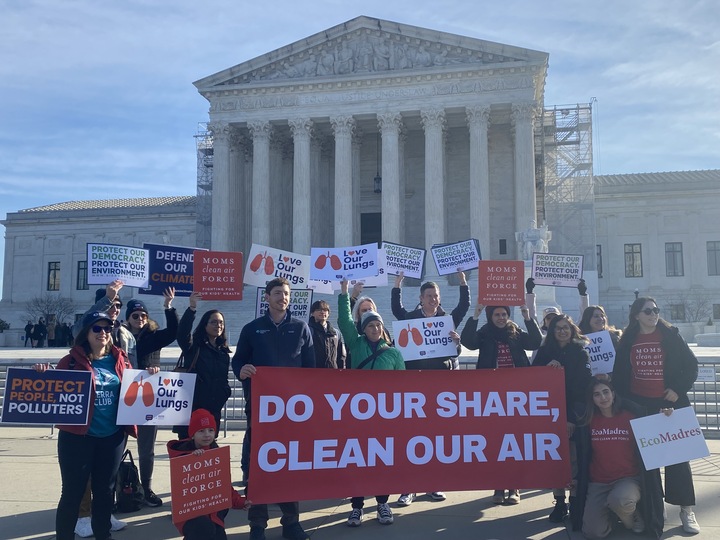WASHINGTON — The Supreme Court heard oral arguments Wednesday on whether to freeze an EPA policy aimed at reducing air pollution that crosses from one state to another in a case that experts say could significantly limit the agency’s ability to regulate air pollution nationwide.
In Ohio v. EPA, the court heard four cases involving challenges of the EPA’s so-called Good Neighbor Plan. Three states – Ohio, Indiana and West Virginia – along with numerous actors in the oil and gas industry are challenging the EPA’s rule that sets national emission standards for certain air pollutants. Among those include ozone, a pollutant that can trigger or exacerbate a wide-range of health issues – like asthma and bronchitis – when present in high levels.
In 2023, the EPA rejected 21 state plans for failing to meet these standards and subsequently introduced the “Good Neighbor Plan,” requiring “upwind” states to ensure that their emissions do not interfere with the ability of “downwind” states to meet federal air quality standards.
The states challenging the Good Neighbor Plan contend it would be costly and pose “irreparable harm” to the states involved. The plaintiffs also argued that the EPA failed to give the states adequate time to make revisions to their plans before the EPA imposed their own regulations.
The nine justices seemed to be divided along ideological lines based on their questioning. Justice Elena Kagan criticized the “generality” of the plaintiffs’ motions, saying that their briefs do not address a “very complicated cost argument.”
Justice Ketanji Brown Jackson also expressed skepticism about the urgency of this particular case, arguing that it was “fairly extraordinary” for the Supreme Court to hear arguments before they have first been considered by a lower circuit court.
“I’m worried about the standards that this court needs to take into account when it decides whether or not to entertain these kinds of motions,” Jackson said. “The (plaintiffs’) argument is just boiling down to ‘we think we have a meritorious claim, and we don’t want to have to follow the law while we’re challenging it.’”
Malcolm L. Stewart, on behalf of the EPA, noted the importance of promoting equity when considering cross-air state pollution, specifically in downwind states disproportionately affected by greater emissions.
Justice Brett Kavanaugh said he was sympathetic to the detriments of air pollution but defended the states challenging the EPA’s plan, pointing out that “there are also the equities of the upwind states and the industry…and they’re both major.”
In an interview with the Medill News Service, Richard J. Lazarus, a professor of law at Harvard University, said he believes there may be at least four justices who would vote in favor of the plaintiffs, noting that it is highly unusual for the court to hear a case on the shadow docket – or cases seeking expedited action from the Supreme Court before lower courts rule on them.
“Historically, the court would have denied it in a heartbeat,” Lazarus said, adding that the Supreme Court has accepted such motions in recent years “in part because they’re concerned that the EPA in particular is overreaching.”
In 2022, the court restricted the EPA’s use of the Clean Air Act to combat emissions that contribute to climate change. Last year, the court weakened the EPA’s regulatory oversight over wetlands under the Clean Water Act.
In 2014, the court ruled in a 6-2 decision that the EPA was well within its authority to impose its own plans to curb air pollution on states under the prior Good Neighbor rule. If the court rules against the EPA, it would signal a reverse in precedent and underscore the political conservatism of the court, according to Lazarus.
“Those are two of the biggest losses the EPA has ever had in the United States Supreme Court within one year,” Lazarus said. “This ruling will tell us whether the court is going to be hyper-aggressive.”
Devon Ombres, senior director for courts and legal policy at the Center for American Progress, a progressive-leaning think tank, told the Medill News Service that pausing the EPA’s plan would bring about dire environmental consequences.
The center predicts that such a pause could allow upwind states to emit approximately 70,000 additional tons of nitrous oxide by the peak of 2026 ozone season, resulting in an estimated 1,300 premature deaths.
“If the EPA can’t regulate air pollution, then what is the point of the EPA?” Ombres asked. “If the EPA can’t act to regulate air pollution of the second-largest carbon polluter in the world, then we are really in for some existential crises in the future.”



